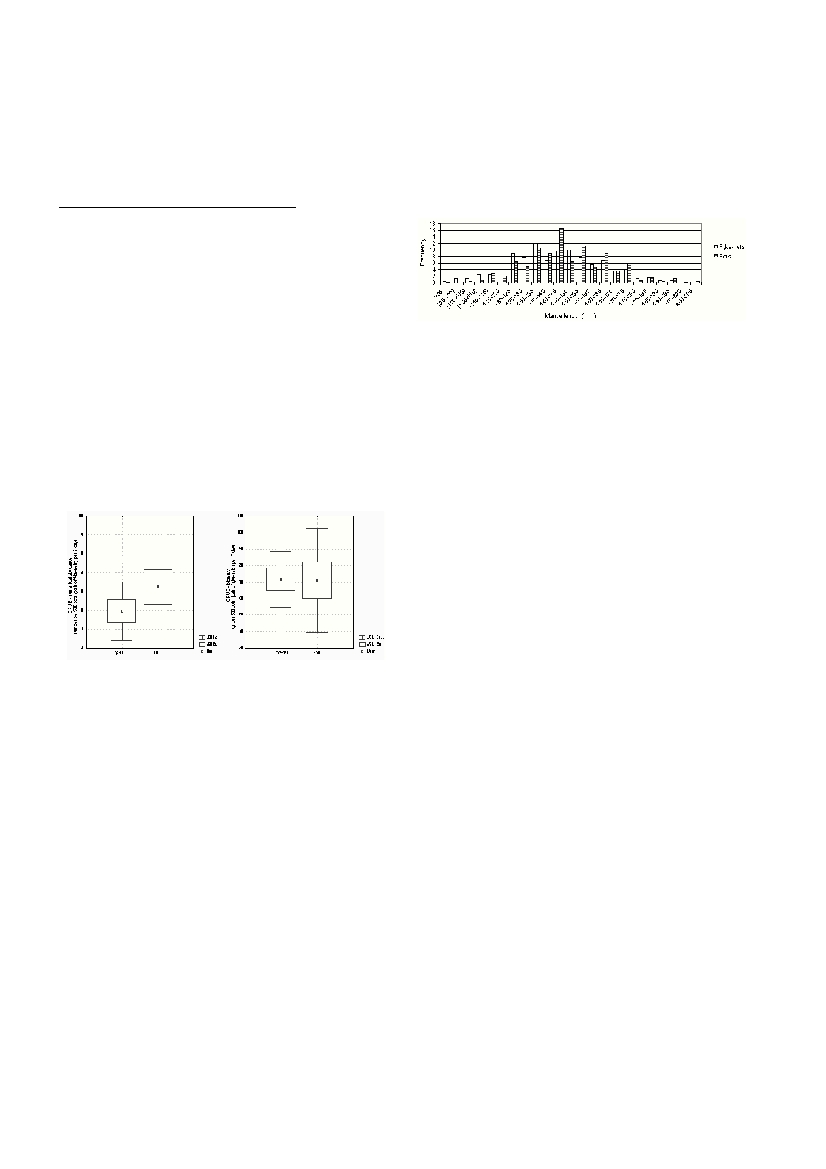Rapp. Comm. int. Mer Médit., 36,2001
279
COMMON OCTOPUS (OCTOPUS VULGARIS, CUVIER 1797) COASTAL FISHERY,
DURING THE PEAK OF SPECIES REPRODUCTION
A. Kallianiotis, P.Vidoris* and A. Kokkinakis
Fisheries Research Institute, National Agricultural Research Foundation, Kavala, Greece - fri@otenet.gr
Abstract
The present paper studies the catchability of fyke-nets and pots used in O. vulgarisfishery in the Thracian Sea. The analysis of variance
showed that the catch per unit effort and the average mantle length of specimens caught by the two gears were similar.The by-catch species
are referred.
Keywords: Octopus, fishery,Aegean Sea, traps
Introduction
Octopus fishery is widespread in the Thracian Sea, North A
egean Sea.
Octopus catches are shared among three fishing gears, trawls, fyke
-
n
e
t
s
and pots. FRI was funded by the region of Eastern Macedonia-Thrace to
study the catches of fyke-nets and pots at the peak of the reproductive
period for the species Octopus vulgaris. The aim of the study was to
support a new legislation on the use of these gears.
Materials and methods
During May to July of 1999, eleven cruise were conducted in the
main octopus fishing grounds in the Thracian Sea. The survey was
restricted to the depth zone of 30-35 m. The substrata were sand with
mud and posidonia meadows. Data were collected by on board sam-
pling on professional fishing vessels using fyke-nets and pots (Fig. 1).
Fyke-nets exist in pairs which are bound together with a gillnet; 36-40
mm full mesh, 50 cm high and 3-4 m long. Pots were made from plas-
tic material with volume 5 liters and opening 9-13.5 cm diameter.A
?eet of fyke-nets usually enumerate 250-450 pairs, while a ?eet of
pots enumerate 800-1200 pots. Both gears were usually set for 5-10
days. Species abundance was recorded in number and weight.
Individuals were measured in mantle length and weighted. The gonad
maturity was recorded in three stages according to Sanchez (1). The
by-catches and the food remains in the gears were also recorded.
Fig. 1. CPUE values expressed in number and biomass for the
two gears, fyke-nets and pots.
Statistical analysis was based on catch per unit of effort (CPUE)
values and mantle length frequencies. CPUE values were calculated in
terms of individuals or biomass per 500 pots (or pair of fyke-nets) per
7 fishing days. The mean CPUEs and mean mantle lengths were com-
pared between the two gears, using one-way analysis of variance. The
Chi-square test was used to examine the preference of females to stay
in pots gluing their eggs.
Results - Discussion
Using 14280 traps in total, 3700 fyke-nets and 10580 pots, 1096
individuals of the species O. vulgariswere caught. The majority of
them, 99.45 %, were recorded at the third maturity stage. The ovaries
of females were very large with plenty of eggs, while the sper-
matophores were visible in the spermatophoric sacs of males.
Considering that a pair of fyke-nets operates like a trap, ANOVA indi-
cates no statistical difference (p>0.05) between the mean CPUEs
(either expressed in individuals or biomass) for the two gears (Fig 1).
However, the values of standard deviations for the two gears indicate
that the CPUE of fyke-nets varies less than pots. This is because the
fyke-nets work like trap while pots catch-ability is highly dependent
on octopus diel activities. Comparing the mean mantle lengths of the
octopus caught in the two gears, ANOVA shows no statistical differ-
ence (p>0.05). The Chi-square test denotes that there were no signifi-
cant difference between the male-female ratio in the two gears.
Fig. 2. Octopus vulgarismantle length frequencies for the
catches of the two gears.
The only by-catches in pots were gobids of the species Gobius niger
and glued eggs of it inside the pots. From the remains of the preys
which were found inside the pots were identified mainly crabs,
Liocarcinus depuratorandGoneplax rhomboidsand less frequent the
speciesGobiusniger,Ophidion barbatum, Conger conger, Cepola
rubescens, Scyliorhinus caniculaandEledone moshata.We also found
bivalves and gasteropods. During the last sampling in the total of 1050
pots 5 octopus males were found as preys of females, and it was denot-
ed that both sexes were mature, third stage. In the fyke-nets as by-
catches were recorded the species L. depurator, G. rhomboides,
Homarus gammarus, Palinurus elephas, C. conger, Spicara ?exuosa,
P. physis, Mulus surmuletus, Muraena elena, Diplodus annularis,
Scorpaena porcus, Scorpaena notata, S. canicula, Trachurus trachu-
rus, Raja miraletus, E. moshataandSepia officinalis.Also eggs of the
speciesLoligo vulgariswere stack outside the trap.
From ourresults it seems that fyke-nets are traps which at the begin-
ning catch fishes and crabs (due to the existence of gill-nets which
drive them inside) and furthermore they attract octopus. These sequen-
tial catches explain why the gear is efficient after 5-10 days of setting.
On the other hand, pots offer a shelter to the octopus in no rocky
places. However, the variability of weather conditions, in relation to
the stability of the light plastic pots to the current, affects the catches.
It was also observed that during full moon the catches in pots were
lower than the average. Stack octopus eggs inside pots were found
only 4 times out of the total of pots used. However, it seems that the
longer time the pots in the sea the more pots with stack eggs inside,
because the better the adaptation of the animal to the new environ-
ment.
Reference
1. Sanchez and R. Obarti, 1993. The biology and fishery of Octopus
vulgariscaugth with clay pots on the Spanish Mediterranean coast. In:
OkutaniT., O' Dor R.K. and T. kubodera (eds). Recent Advances in
Fisheries Biology - Contributed Papers to 1991 CIAC International
Symposium and Proceedings of the Workshop on the Age, Growth and
Population Structure. Tokai University Press. pp. 477-487

